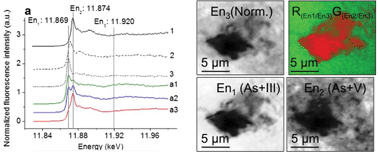Visualization of As(iii) and As(v) distributions in degraded paint micro-samples from Baroque- and Rococo-era paintings
Abstract
Orpiment and realgar, both arsenic sulfide pigments respectively used for their vivid yellow and red-orange hues, are two of many artists' pigments that appear not to be stable upon light exposure, quickly degrading to arsenic trioxide and arsenate. This often results in whitening or transparency in the painted surfaces. While conventional techniques such as microscopic Raman (μ-RS) and microscopic Fourier transform infrared (μ-FTIR) spectroscopies can allow a quick and relatively easy identification of the orpiment, realgar, artificial arsenic sulfide glass and, to some extent, arsenic oxide, the identification and visualization of distributions of the degradation products – and especially arsenate compounds – in the paint micro-samples is generally more challenging. This challenge is due to the rather unfavorable limit of detection and low spectral resolution of such conventional spectroscopic techniques. This restricts the conclusions that can be drawn regarding the conservation state of valuable works of art. In this paper, we present how synchrotron radiation (SR) based techniques can overcome this challenge while working on painting cross-sections taken from a 17th-century painting by the Flemish artist Daniël Seghers (oil on canvas, Statens Museum for Kunst, Denmark) and an 18th-century French Chinoiserie (private collection, France). SR micro-X-ray fluorescence (μ-XRF) mapping analysis performed on a visually degraded orpiment-containing paint stratigraphy reveals that arsenic is distributed throughout the entire cross-section, while X-ray absorption near edge structure (μ-XANES) demonstrated that the arsenic is present in both arsenite (As-III) and arsenate (As-V) forms. The latter compound(s), despite being barely identifiable by means of FTIR, were not only located at the surface of large and partially altered grains of arsenic sulfide but also spread throughout the entire paint stratigraphy. Their presence and distribution are attributed either to the complete degradation of smaller arsenic sulfide grains or to migration of the arsenates within the paint layer away from their original location of formation. The combination of μ-XRF and μ-XANES was very useful for the characterization of the advanced degradation state of the arsenic-containing pigments in paint systems; this type of information could not be obtained by means of conventional spectroscopic methods of microanalysis.

- This article is part of the themed collection: Speciation Analysis

 Please wait while we load your content...
Please wait while we load your content...